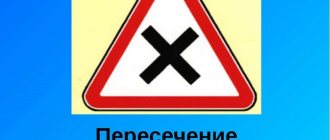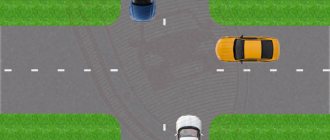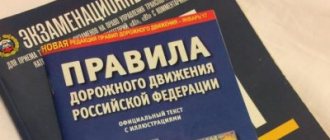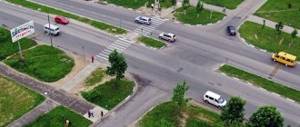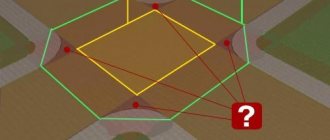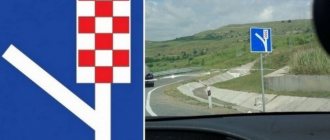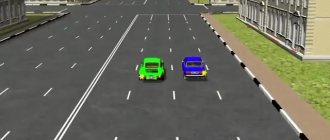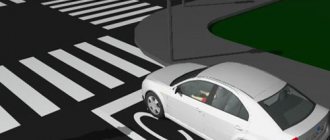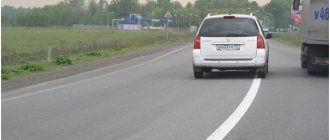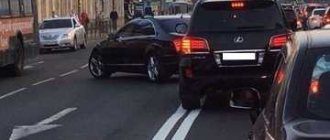Traffic rules provide for concepts such as main and secondary roads, which help indicate the priority of vehicle (Vehicle) movement. If two equivalent roads intersect, this is indicated by a certain warning sign. Traffic at such an intersection has its own characteristics.
- Intersection of equivalent roads in traffic regulations
- Travel rules U-turn
- Overtaking
- Who gives in
- Video: General rules at equivalent intersections
Intersection of equivalent roads in traffic regulations
Let's take a look at the definition of “equivalent roads”:
- these are intersections without regulation (with a yellow light that is flashing, a broken traffic light, or the absence of an inspector to carry out the regulation);
- at the intersection there are no signs indicating priority for vehicle traffic;
- intersecting roads have the same surface (asphalt or dirt).
Did you know? The very first road signs were adopted at the International Motorists' Conference in 1909. These were 4 signs in the form of a circle, which signaled that there was an “intersection”, “barrier”, “double turn”, “obstacle in the form of an embankment and a ditch” ahead.
This sign is installed as follows:
- in populated areas - 50–100 m before the intersection;
- outside residential areas - 150–300 m before the intersection of road routes.
Travel rules
There are certain rules of passage when driving at the intersection of equivalent roads.
U-turn
According to clause 13.11 of the traffic rules, the driver must allow a vehicle driving on the right to pass. Moreover, it does not matter which side it was on when entering the intersection. If during the turn it turns out to be on the right, then the driver must let it pass. If there is no traffic on the right side, you can pass. Important! When there is a traffic police representative at an intersection regulating vehicle traffic, or a traffic light, their instructions are more important than road signs.
It is worth remembering that the driver should not interfere with the movement of other vehicles when driving and turning around, so you should not:
- suddenly change driving direction;
- sharply reduce or increase the speed of movement.
Before turning, you must take the far left lane and avoid entering the oncoming lane, choosing the farthest turning trajectory. If there are prohibiting signs, then you should look for another place to turn around. Vehicles without the right of way are not allowed to enter the intersection if there is a traffic jam and they interfere with the free movement of other vehicles. Starting from 2021, the section of the intersection that the driver is not allowed to enter is marked yellow.
Did you know? At the beginning of 2021, the traffic police approved the proposal of the Moscow authorities to reduce the current standard of road signs from sizes 60x60 cm to 40x40 cm and 35x35 cm.
Overtaking
At the intersection of equivalent roads, overtaking other vehicles is prohibited. This is a strict rule that applies to non-main roads, and at the intersection of equivalent roads there is no main road. This maneuver will be accompanied by driving into the oncoming lane, which in such a tense and dangerous area as an intersection can lead to an accident, so overtaking at such an intersection will result in a considerable fine and temporary deprivation of driving privileges.
Who gives in
The basic principle of traffic rules (clause 13.11) is to give way to the one on the right. If at the intersection of road routes a situation occurs when each of the drivers experiences “interference on the right,” then they must independently decide the order of passage by quickly switching the low and high beam headlights. Important! At intersections, the tram has priority over other vehicles moving.
Such blinking will say “I’m the last one going,” that is, the driver giving such a signal allows other cars to pass. In the event that the driver with priority must make a U-turn or turn the car to the left, he is obliged to let other traffic moving towards him pass.
Key Aspects
traffic ticket 1 question 9
Equivalent intersections are divided into two types - regulated and unregulated. If the car owner needs to drive through the first type of road intersection, he will simplify his task.
In this case, the person will receive instructions that will allow him to understand how to act in the current situation.
Otherwise, the intersection ceases to be of equal importance, because priorities are set. There are a number of rules that must be followed at the intersection of equivalent roads.
The list includes the following statements:
| If the traffic light is operating in standard mode | The movement of vehicles must be carried out in accordance with its instructions |
| If traffic on a section of the road is controlled by a traffic controller | Drivers are required to follow his instructions. Moreover, its commands have higher priority than traffic light signals. The point is that sometimes you need to adjust the movement manually. The traffic light, in the presence of a traffic controller, fades into the background |
| If crossing a section of the highway is carried out under a red light and there is a green sign | It is necessary to give way to cars whose trajectory coincides with the path of the driver’s vehicle. |
Experts advise periodically refreshing your memory of traffic rules. This will allow the driver to know exactly what to do in the current situation.
In addition, if the vehicle owner follows traffic rules, the likelihood of accidents will be minimized.
What it is
An intersection is an intersection of roads at the same level. In city conditions, such a phenomenon happens quite often, but on the highway the need to overcome road intersections is less common.
Once near an intersection, the driver must determine its type. It depends on how this or that type of transport will behave when it is about to drive straight or make a U-turn.
Typically, an equivalent intersection is not regulated by any of the known methods.
In addition, for the intersection of highways to be considered equivalent, all roads that intersect must have the same surface.
Not all drivers know that the material of which the road is made determines whether there is an advantage.
It is believed that asphalt has a greater advantage than a road made of other materials.
There are a number of other features, the presence of which may lead to the intersection being considered unregulated. These include:
- The presence of a non-working traffic light.
- The traffic light is flashing yellow without switching to others.
- The regulator does not carry out the duties that were assigned to him.
In most cases, missing pointers cause problems. Drivers do not understand how to behave in the current situation, and act as they see fit.
To avoid their occurrence, it is necessary to follow the rules that apply when the driver crosses equal and unequal roads.
Main functions of traffic rules
The traffic rules stipulate a number of rules that must be followed when crossing an intersection of equivalent roads.
However, in practice, the most difficult thing to determine is that an intersection is such.
The function of traffic rules is to help the driver figure out how to distinguish the intersection of equivalent roads from other types of intersections, and understand how to act in a specific situation.
He wears number 1.6. The presence of a sign means that each of the roads that intersect is not the main one. People driving on such roads in private cars do not have any advantages.
How to identify a main road without signs
A certain sign will indicate that the car is approaching the main road. But if it is not there, then you can identify the main route by the following characteristics:
- if it has a hard surface structure, while others are unpaved;
- any road sections that leave the residential area (from the yard) are classified as secondary.
Important! If the driver cannot identify the road, and the corresponding signs are missing, then he must classify it as secondary.
The hard surface of the route includes not only asphalt, but also paving stones, bricks, reinforced concrete slabs, and rubble stone. Compared to dirt roads, all of these road routes are considered major routes. There is only one main road, and all cars that move along it have the right of way. Secondary roadways are those that cross or approach the main highway. The route may first be the main one and then change its priority, but it is never interrupted at an intersection.
Liability for violation of sign 1.6
Sign 1.6 refers to warning types of signs. Responsibility for failure to comply with the restrictions that it establishes will arise in accordance with Article 12.13 of the Code of Administrative Offenses of the Russian Federation.
Sanctions will be applied for:
- Failure to provide the right of way.
- Creating obstacles to traffic (driving onto a roadway filled with parked cars).
If photo and video recording is carried out at an intersection, the driver will be issued an administrative violation report and a fine equal to 1,000 RUB.
In addition, liability may arise under other articles of the Code of Administrative Offenses if the driver:
- will overtake another car at an intersection. For such an offense, financial sanctions are provided (fine 5,000 RUB). Or the use of restrictive measures - the driver’s license will be temporarily suspended. The deprivation will last from 4 to 6 months (part 4 of article 12.15);
- will not turn on the turn signal before performing a maneuver (right or left turn, U-turn, stop). Threatens with a verbal warning or a monetary penalty of 500 RUB (Part 1 of Article 12.14).
All these errors appear due to insufficient theoretical knowledge. And they are not considered a basis for releasing the driver from liability.
- Description
- Adjustable
- Unregulated
- Explanation
- the main road
- minor road
- Equivalent intersection
- Coverage area
- Comments
- Exceptions
- Anticipated fines
- Equivalent intersection
First, let's define what is meant by the word “road intersection”.
This is the point or place where roads cross at the same level. The boundaries of the intersection are virtual lines that visually unite the beginnings of the curves of the roadways. The key word in our formulation is “intersection”. At this point, one car must let another car pass, in accordance with section 13 of the Road Traffic Rules (hereinafter referred to as traffic rules).
In order to easily understand the traffic situation and correctly determine who will cross the road intersection first and who should wait a little, you need to accurately navigate which intersection you find yourself at.
General rules at equivalent intersections
There are other general rules for driving at equivalent intersections of roads, which any person driving a vehicle must adhere to:
- Before turning or turning, the driver must move the car in advance to a convenient edge on the road for movement.
- Reversing is not allowed at intersections and in places where you cannot turn around.
- On two-way highways that have 4 or more lanes, you must not enter the oncoming lane when trying to overtake a vehicle or go around an obstacle.
- There is a ban on stopping at the intersection and up to 5 m from the edge of the intersection of the road section. The exception is the side opposite the side passage of 3-way intersections, which is marked with a solid line or stripe.
- When turning, the driver must allow pedestrians and cyclists moving along the roadway onto which the car plans to turn to pass.
- It is strictly prohibited to enter an intersection with markings if there is a traffic jam ahead along the vehicle’s trajectory that will cause a forced stop. The exception is turning right/left.
Video: General rules at equivalent intersections
When crossing uncontrolled intersections, you must adhere to the following rules:
- At the intersection of equivalent roads, the driver must give the right of way to vehicles driving on the right.
- When turning to the left and making a U-turn, the driver gives way to vehicles that are moving on an equivalent route in a straight line or want to turn to the right.
Recommended reading:
- Traffic rules and signs when turning right
- Traffic rules about winter tires
- Traffic rules: sign “Driving in lanes at the intersection”
- Traffic violations recorded by camera
Road signs every pedestrian should know
Ticket 7 Question 2
The truths of road traffic apply and apply to absolutely everyone who takes part in this traffic, and the pedestrian is no exception to this list. By moving on our own feet, we can also create an emergency situation on the road, which may be caused by inattention. But most often the reason for this turn of events is ignorance of the traffic rules and signs that are mandatory for pedestrians.
However, most of the signs that serve to warn pedestrians are intuitive. Therefore, the most common cause of accidents and other unpleasant situations caused by pedestrians is blatant inattention and distraction on the road. Be careful and be sure to learn the minimum required traffic rules. Let's start with signs for pedestrians.
The most necessary road signs for pedestrians
Among dozens of various signs that permit and allow the driver to perform certain maneuvers, there are signs that help the pedestrian to correctly cross the roadway and remain safe and sound. The required minimum of road signs for pedestrians includes the following options:
"Crosswalk"
Here they will give way to you even if the zebra crossing is not painted on the asphalt. All crossings marked with zebra crossings are also delimited by signs. The transition zone operates from sign to sign, and not along road markings.
"No Pedestrians"
This is a sign prohibiting walking in a certain area. This could be a highway where even walking on the side of the road is unsafe for life.
"Underground pedestrian crossing"
This sign means that pedestrians not only can, but are required to use the underground passage. Crossing the road at a place marked with this sign is an unsafe way to cross the road, especially on wide roads without pedestrian crossings on asphalt.
"Public transport stop"
There are three signs of this type for different transport - bus, tram and taxi. For pedestrians, they mean that at this place you can wait for the necessary transport to move around the city, and for drivers - a prohibition on stopping in the area where this sign is valid.
There are no longer any special road signs for pedestrians. Of course, some benefit can be derived from other signs. For example, if you are walking along the side of the road and see a sign “Wild animals on the road” or “Possible rockfall”, you should speed up your step a little and beware of certain obstacles for further movement. But these signs are not considered useful for pedestrians.
Markings and general rules for crossing streets
The most useful road marking for pedestrians is the zebra crossing, which represents a pedestrian crossing.
But we can also note the importance of other markup options. If in front of you is a six or eight lane road with no markings for pedestrians, you should not cross the road in this place - it can be dangerous
Look around, most likely there is a crossing nearby that is controlled by a traffic light.
It is very important to respect the pedestrian crossing area, which is limited by signs. In the event of any dispute, you will not be able to prove that you are right.
Let's sum it up
To ensure safety on the road, not only drivers must know and comply with the terms and conditions of traffic rules, but also pedestrians, cyclists, owners of mopeds and other vehicles. This is the only way to achieve complete safety on the road. Of course, no one is immune from the actions of reckless drivers, but the use of road signs and rules creates the safest and most secure travel conditions for you.
Learn a small set of pedestrian signs and get maximum safety when crossing the roadway. I wonder if our blog readers often break traffic rules?
avto-flot.ru
Liability for violation of sign requirements
For violations of the “Crossing of Equivalent Roads” sign, the following fines are possible:
- for driving to an intersection when there is a traffic jam ahead, the driver can be fined 1 thousand rubles;
- a driver who did not allow transport to pass according to the rules will also be fined 1 thousand rubles;
- if the driver did not turn on the appropriate signal before turning, the traffic inspector may issue a fine of 500 rubles;
- if the person driving the car does not take the required position on the road before turning or turning, then he will also be fined 500 rubles;
- from 2021, for ignoring the advantage of the movement of pedestrians and cyclists, a fine of up to 1.5 thousand rubles will be issued;
- for overtaking or driving into oncoming traffic at the intersection of equivalent roads, a fine of 5 thousand rubles is imposed, as well as deprivation of rights for 4–6 months.
Nowadays, on many difficult sections of the road there are video surveillance cameras that quickly record all violations on the roadway. Therefore, in order not to receive a fine and not cause an accident or traffic jam, you need to take the study of traffic rules seriously and remember well the designations of all road signs. The “Intersection of Equivalent Roads” sign signals drivers that there is a nearby intersection, when driving through which they must follow the priority “obstruction on the right”, and overtaking at them is strictly prohibited. The crossing of intersections is described in more detail in Section 13 of the Traffic Regulations.
Source:
Requirements of the sign Intersection of equivalent roads
According to traffic rules, an intersection is the intersection of carriageways of different roads at the same level.
It may be called:
- Adjustable. On it, the order of passage is determined by the light signals of the traffic light or the instructions of the traffic controller.
- Unregulated. You need to navigate by priority signs.
In turn, uncontrolled intersections are divided into equivalent and unequal. Each move has its own characteristics.
If a driver is driving on a road designated as the main road, then the installed sign at the intersection of equivalent roads (1.6) indicates that he does not have the right of way. In this case, the traffic rules regarding obstacles on the right come into effect - that is, you need to yield to those who are on the right hand of the driver. Those approaching from the left are not given priority.
A picture with a detailed description and explanation can be viewed on Internet resources dedicated to traffic rules and preparation for the theoretical part of the exam.
- reduce speed;
- cross the road only by giving way to vehicles approaching from the right (clause 13.11);
- give way to rail vehicles regardless of which direction they are moving from.
